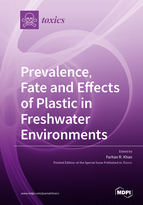Prevalence, Fate and Effects of Plastic in Freshwater Environments
A special issue of Toxics (ISSN 2305-6304). This special issue belongs to the section "Environmental Chemistry".
Deadline for manuscript submissions: closed (29 February 2020) | Viewed by 38605
Special Issue Editor
Interests: plastics and microplastic pollution; microplastic vector effects; nanoparticles and nanoplastics; ecotoxicology and ecophysiology; ecotoxicology in the Anthropocene
Special Issues, Collections and Topics in MDPI journals
Special Issue Information
Dear Colleagues,
Plastic (and microplastic) pollution has been described as one of the greatest environmental challenges of our time, and a hallmark of the Anthropocene. It has grabbed the attention of the general public, governments, and environmental scientists worldwide. Up until recently, the main focus has been on plastics in the marine environment, but interest into the presence and effects of plastics in freshwaters has increased in the last few years. The occurrence of plastics within inland lakes and rivers, as well as their biota, has been demonstrated in a handful of studies. Experiments with freshwater organisms have started to explore the direct and indirect effects resulting from plastic exposure. There is a clear need for further research, and a dedicated space for its dissemination.
This Special Issue is devoted to highlighting current research from around the world into the prevalence, fate, and effects of plastic in freshwater environments. Authors are invited to submit original research papers, reviews, and short communications. Topics may include, but are not limited to, the following:
- Plastic debris of all size ranges (macro-, meso-, micro-, and nano-plastics) in freshwaters
- Sources, fate, and transport in the freshwater environment
- Sampling and monitoring, and the associated challenges, from different freshwater compartments (e.g., water, sediments, and biota)
- Degradation, characterization, and analysis of environmental plastic samples
- Plastic ingestion and retention by freshwater organisms
- Toxicity and biological impacts
- Plastics as chemical and biological vectors
- Citizen science and stakeholder involvement
- Regulation and management
- Knowledge gaps and future research needs
- Mitigation and solutions
Assoc. Prof. Farhan Khan
Guest Editor
Manuscript Submission Information
Manuscripts should be submitted online at www.mdpi.com by registering and logging in to this website. Once you are registered, click here to go to the submission form. Manuscripts can be submitted until the deadline. All submissions that pass pre-check are peer-reviewed. Accepted papers will be published continuously in the journal (as soon as accepted) and will be listed together on the special issue website. Research articles, review articles as well as short communications are invited. For planned papers, a title and short abstract (about 100 words) can be sent to the Editorial Office for announcement on this website.
Submitted manuscripts should not have been published previously, nor be under consideration for publication elsewhere (except conference proceedings papers). All manuscripts are thoroughly refereed through a single-blind peer-review process. A guide for authors and other relevant information for submission of manuscripts is available on the Instructions for Authors page. Toxics is an international peer-reviewed open access monthly journal published by MDPI.
Please visit the Instructions for Authors page before submitting a manuscript. The Article Processing Charge (APC) for publication in this open access journal is 2600 CHF (Swiss Francs). Submitted papers should be well formatted and use good English. Authors may use MDPI's English editing service prior to publication or during author revisions.
Keywords
- Macro-, meso-, micro-, and nano-plastics
- Freshwaters and inland waters
- Polymers
- Characterization and analysis
- Sources, presence, and fate
- Sampling and monitoring studies
- Plastic ingestion and retention
- Vector effects
- Toxicity and biological impacts
- Regulation and management.







